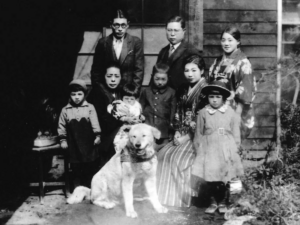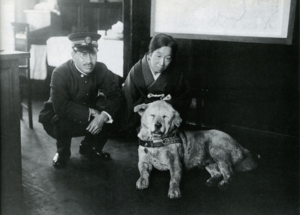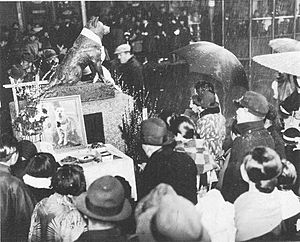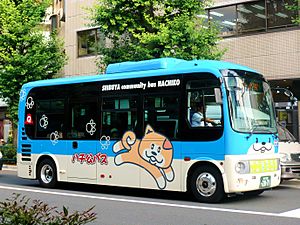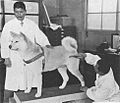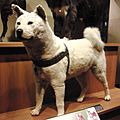Hachikō facts for kids
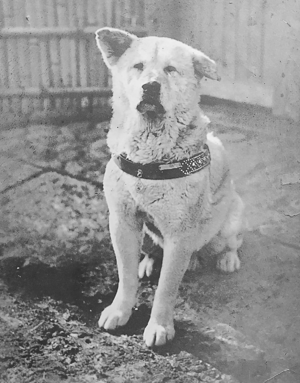
Hachikō (c. 1934)
|
|
| Species | Dog (Canis familiaris) |
|---|---|
| Breed | Akita Inu |
| Sex | Male |
| Born | November 10, 1923 near the city of Ōdate, Akita Prefecture, Japan |
| Died | March 8, 1935 (aged 11) Shibuya, Tokyo, Japan |
| Resting place | Aoyama Cemetery, Minato, Tokyo |
| Known for | Faithfully waiting for the return of his deceased owner for more than nine years until his death. |
| Title | Chūken Hachikō (忠犬ハチ公, 'faithful dog Hachikō') |
| Owner | Hidesaburō Ueno |
| Weight | 41 kg (90 lb) |
| Height | 64 cm (25 in) |
| Appearance | White (peach white) |
| Awards |
|
Hachikō (ハチ公, November 10, 1923 – March 8, 1935) was a famous Japanese Akita dog. He is remembered for his amazing loyalty to his owner, Hidesaburō Ueno. Hachikō waited for his owner for over nine years, even after Ueno had passed away.
Hachikō was born on November 10, 1923, on a farm near Ōdate, Akita Prefecture. In 1924, Professor Hidesaburō Ueno from the University of Tokyo adopted Hachikō. They lived in Shibuya, Tokyo. Every day, Hachikō would go to Shibuya Station to meet Professor Ueno after work. This special routine continued until May 21, 1925. On that day, Professor Ueno sadly died from a brain hemorrhage while at work. He never returned to the station. But Hachikō kept going back to Shibuya Station every day. He waited there for Ueno until his own death on March 8, 1935.
During his life, Hachikō became a symbol of loyalty in Japan. People all over the world still remember him today. There are statues, movies, and books about him. In Japanese, Hachikō is called chūken Hachikō (忠犬ハチ公, "faithful dog Hachikō"). The name Hachikō means "Mr. Eight" or "Sir Eight."
Contents
The Loyal Life of Hachikō
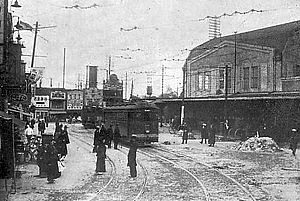
Hachikō was a white Akita dog. He was born on November 10, 1923, in Ōdate, Akita Prefecture, Japan. In 1924, Professor Hidesaburō Ueno adopted Hachikō. Professor Ueno taught at the University of Tokyo. He brought Hachikō to live with him in Shibuya, Tokyo.
Professor Ueno traveled to work each day. Hachikō would leave the house to meet him at Shibuya Station. They did this every day. But on May 21, 1925, Professor Ueno did not come back. He had a brain hemorrhage while teaching. He passed away without returning to the station.
For the next nine years, nine months, and fifteen days, Hachikō waited. He appeared at the station exactly when Ueno's train was supposed to arrive.
Other people at the station noticed Hachikō. Many commuters had seen Hachikō and Professor Ueno together. At first, some station workers were not very kind to the dog. But then, an article about Hachikō was published. It appeared in the Asahi Shimbun newspaper on October 4, 1932. After that, people started bringing Hachikō food and treats. They wanted to help him during his long wait.
Hachikō's Story Becomes Famous
One of Professor Ueno's students was Hirokichi Saito. He knew a lot about the Akita dog breed. Saito saw Hachikō at the station. He followed the dog to the home of Ueno's former gardener. There, he learned Hachikō's amazing story.
Soon after, Saito published a report about Akita dogs in Japan. His research showed that only 30 purebred Akitas were left. Hachikō was one of them.
Saito often visited Hachikō. Over the years, he wrote several articles about the dog's incredible loyalty. In 1932, one of his articles was published in the Asahi Shimbun newspaper. This article made Hachikō famous across Japan.
Hachikō became a national hero. His loyalty to his owner's memory deeply impressed the Japanese people. He became a symbol of family loyalty. Teachers and parents used Hachikō's story to teach children about faithfulness. A sculptor named Teru Ando even made a statue of the dog. People also became more interested in the Akita dog breed.
Eventually, Hachikō's loyalty became a national symbol. It represented loyalty to family and even to the Emperor.
Hachikō's Passing
Hachikō died on March 8, 1935. He was 11 years old. He was found on a street in Shibuya. In 2011, scientists figured out why Hachikō died. He had both cancer and a worm infection. There were also four yakitori skewers in his stomach. But these skewers did not cause his death or hurt his stomach.
Hachikō's Lasting Legacy
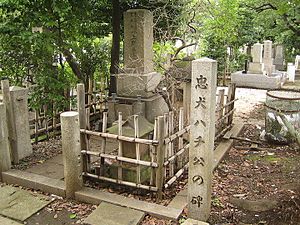
After Hachikō died, his body was cremated. His ashes were buried in Aoyama Cemetery, Minato, Tokyo. They rest next to his beloved owner, Professor Ueno. Hachikō's fur was also preserved. His taxidermy mount is now on display. You can see it at the National Science Museum of Japan in Ueno, Tokyo.
Bronze Statues of Hachikō
In April 1934, a bronze statue of Hachikō was placed at Shibuya Station. It was made by Teru Ando. But during World War II, the statue was melted down to make materials for the war. In 1948, Takeshi Ando, the son of the first artist, made a second statue. This new statue was put up in August 1948. It is still there today and is a very popular meeting spot. The station exit near this statue is called "Hachikō-guchi." This means "The Hachikō Entrance/Exit." It is one of Shibuya Station's five exits.
Another similar statue stands in Hachikō's hometown. It is in front of Ōdate Station and was built in 1932. In 2004, a new statue of Hachikō was put up in front of the Akita Dog Museum in Ōdate.
After the American movie Hachi: A Dog's Tale (2009) came out, another statue was made. The movie was filmed in Woonsocket, Rhode Island. The Japanese Consulate in the U.S. helped to put an identical statue of Hachikō there. It is at the Woonsocket Depot Square. This was the location of the "Bedridge" train station in the movie.
On March 9, 2015, a new bronze statue was unveiled. It is at the Faculty of Agriculture of the University of Tokyo. This statue shows Professor Ueno returning to meet Hachikō. It was made to remember the 80th anniversary of Hachikō's death. The statue was sculpted by Tsutomu Ueda. It shows a very excited Hachikō jumping up to greet his owner. Ueno is wearing a hat, suit, and trench coat. His briefcase is on the ground. Hachikō wears a special harness, like in his last photos.
Annual Ceremony for Hachikō
Every year on March 8, people honor Hachikō's loyalty. A special ceremony is held at Shibuya Station. Hundreds of dog lovers often come to remember his memory and faithfulness.
Hachikō's Bark Recorded
In 1994, a Japanese radio station, Nippon Cultural Broadcasting, did something amazing. They were able to get a recording of Hachikō barking. The sound came from an old record that was broken into many pieces. A huge advertising campaign followed. On Saturday, May 28, 1994, millions of radio listeners tuned in. They heard Hachikō's bark, 59 years after he died.
Shibuya Hachikō Minibus
In 2003, a special minibus started running in Shibuya. It is officially called a "community bus." But it is nicknamed "Hachikō-bus." There are four different routes. People riding this bus can hear a theme song called Hachiko-basu no uta (ハチ公バスのうた).
Rare Photos of Hachikō
In July 2012, some rare photos of Hachikō were shown. They were part of an exhibition at the Shibuya Folk and Literary Shirane Memorial Museum. This museum is in Shibuya.
In November 2015, a photo of Hachikō that no one had seen before was published. A bank employee in Tokyo took the picture in 1934. It shows Hachikō relaxing by himself in front of Shibuya Station.
Yaeko Sakano: Hachikō's Other Caretaker
Yaeko Sakano (坂野 八重子, Sakano Yaeko) was Professor Ueno's partner for about 10 years. She was often called Yaeko Ueno. Hachikō was very happy and loving towards her whenever she visited him. Yaeko passed away on April 30, 1961, at age 76. She was buried in a temple in Taitō. This was far from Ueno's grave, even though she wanted to be buried with him.
In 2013, Professor Sho Shiozawa found Yaeko's old records. They showed that she had wanted to be buried with Ueno. Shiozawa was also in charge of Ueno's grave at Aoyama Cemetery.
On November 10, 2013, which was Hachikō's 90th birthday, Shiozawa and Keita Matsui felt it was important. They believed Yaeko should be buried with Ueno and Hachikō.
It took about two years to make this happen. Both the Ueno and Sakano families agreed. They also had to work with the Aoyama Cemetery management. Shiozawa was also involved in creating the bronze statue of Hachikō and Ueno. That statue was unveiled at the University of Tokyo on March 9, 2015. It marked 80 years since Hachikō's death.
Hachikō's Family Reunited
On May 19, 2016, a special ceremony took place at Aoyama Cemetery. Both the Ueno and Sakano families were there. Some of Yaeko Sakano's ashes were buried with Ueno and Hachikō. Her name and death date were carved on Ueno's tombstone. This finally reunited Hachikō's family.
"By putting both names on their grave, we can show future generations that Hachikō had two caretakers," said Professor Shiozawa. Matsui added, "To Hachikō, the professor was his father, and Yaeko was his mother."
Images for kids
Similar Cases of Loyal Dogs
See also
 In Spanish: Hachikō para niños
In Spanish: Hachikō para niños
- Balto
- Fido (dog)
- Greyfriars Bobby
- List of individual dogs
- Kostya
- "Man's best friend"
- Nipro Hachiko Dome
- Pet ownership in Japan
- Stargazing Dog, a manga about an exceptionally loyal pet.
- Togo (dog)


